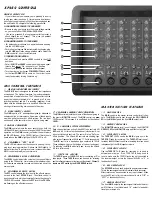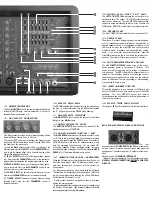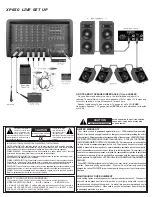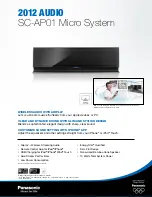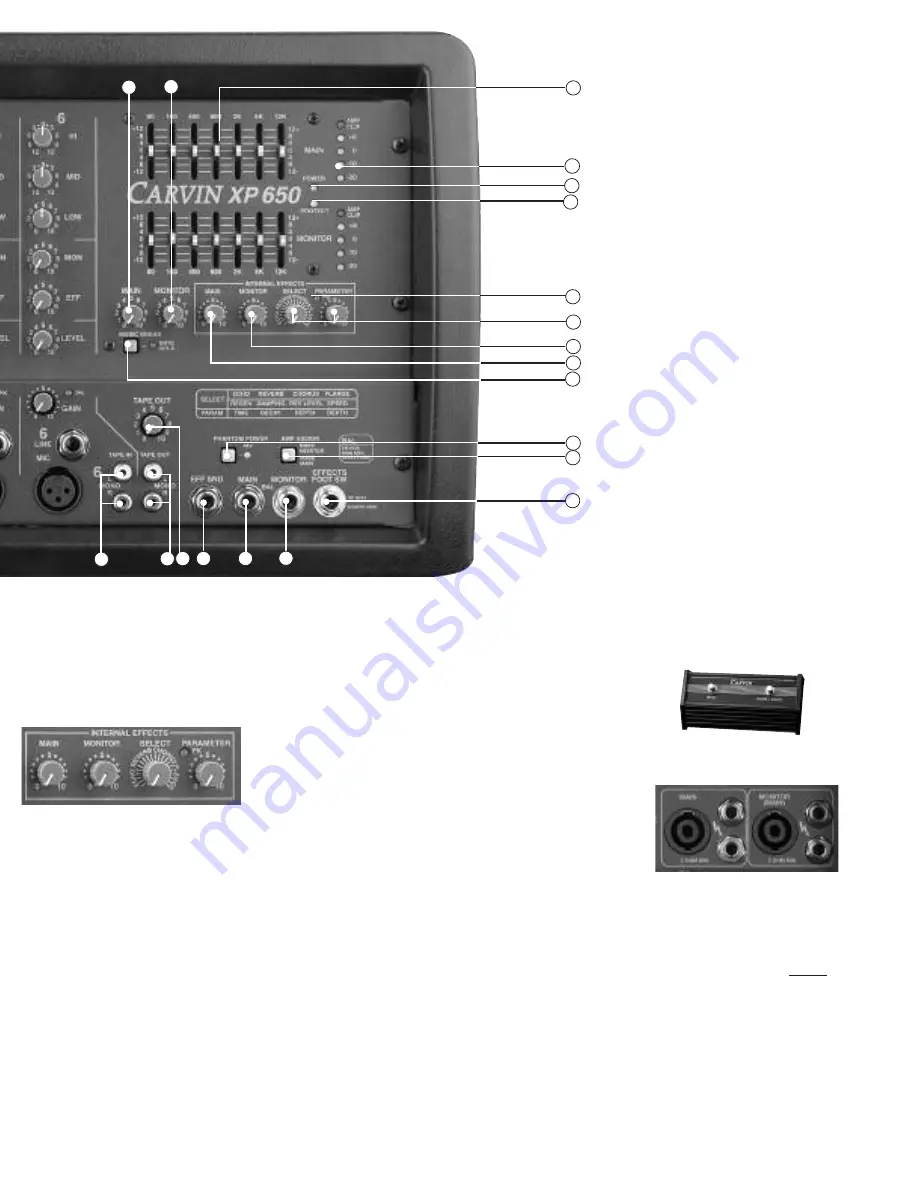
18. MONITOR OUTPUT
The front MONITOR output is the same signal that feeds the
internal MONITOR amp. Use this balanced 1/4” output to
feed additional power amps, etc..
19. DSP EFFECTS PROCESSOR
A 24-Bit processor provides a host of great sounding effects
including Flange, Reverb, Echo, & Chorus.
The channel EFF send control delivers the signals to the
processors.Note: Reduce these levels if the red PEAK LEDs
are flashing on the processors.
Turn up the MAIN effects control to add your effects to the
MAIN outputs. Adjust the SELECT and the PARAMETER con-
trols to get the desired effect. Note: An audible noise will be
heard while adjusting the effects.
A) ECHO: SELECT the amount of the regeneration (repeat-
ing). Now select the PARAMETER control for the shortest or
longest delay time between the original signal and the echo.
B) REVERB: SELECT the amount of presence (high frequen-
cies) in the reverb. Now turn the PARAMETER control to pro-
vide the minimum or maximum decay.
C) CHORUS: SELECT the amount of reverb with your chorus.
Now turn the PARAMETER control to increase the depth.
D) FLANGE: SELECT the amount of speed with your flange
(phasing effect). Now turn the PARAMETER control to
increase the depth.
20. EFFECTS PEAK LED’s
The PK LED indicates that the signal level to the processor is
too high. To prevent distortion, turn the EFF control towards
the “0” (off) position until the PK LED stops flashing.
21. MAIN EFFECTS CONTROL
The MAIN EFFECTS level controls the amount of the effects
that go to your MAIN outputs.
22. MONITOR EFFECTS LEVEL
The MONITOR EFFECTS level controls the amount of the
effects that go to your MONITORS.
23. MUSIC BREAK SWITCH / LED
The MUSIC BREAK feature turns off all inputs, except for chan-
nel 6. This is useful during breaks. This allows pre-recorded
music to be played through the TAPE IN jacks. The channel 6
MIC/LINE inputs are left active for announcements or solo
acts. The remaining input channels (1-5) are turned OFF
eliminating feedback or other unwanted sounds from open
mics during breaks or changes. The LED indicates the MUSIC
BREAK is ON. The internal effects are also muted.
24.
GRAPHIC EQ MAIN + MONITOR
When the EQ sliders are in their center position, they do not
affect the audio signal. When EQ sliders are raised or low-
ered from this position, they boost or cut a narrow fre-
quency band.
For tone enhancement you may want to raise the 80Hz and
160Hz sliders (for deeper bass) and the 6kHz and 12kHz slid-
ers (for crisper highs) while reducing the 400Hz, 800Hz and
2kHz sliders in a moderate “curve”.
To help prevent feedback, microphones should be placed
behind the main speakers.
To reduce feedback in the low frequency range, try lowering one of
the 80Hz or 160Hz sliders. High frequency feedback is usually
reduced by lowering the 2kHz or 6kHz sliders.
25. OUTPUT LED’s /AMP “CLIP” LED’s
The OUTPUT METER LEDs indicate the output levels for
each power amp. The yellow “+6” LED indicates the output
level is near maximum. The red CLIP LEDs indicate when
the power amps are starting to distort (clip). Reduce the
MAIN and/or MONITOR master levels to prevent distortion.
26. POWER LED
The blue POWER LED indicates the mixer is powered ON.
27. PROTECT LED
The mixer will “protect”, engaging relays to mute the speak-
ers if: a) impedance is below minimum on any amplifier b)
shorted speaker cables, or c) ventalation problems. If the
LED comes on, shut the mixer OFF and check for cable
problems, proper impedance and obstructed rear cooling
vents. If you encounter an over-heat problem, leave the
mixer ON allowing the fan to cool down the internal com-
ponents. The mixer will auto-reset in about 5 minutes.
28. 48V PHANTOM POWER
SW/LED
The 48V PHANTOM POWER switch turns on the micro-
phone phantom power in the channel XLR jacks. This
power is used for supplying a high voltage to condenser
microphones. The LED indicates the phantom power is
turned on. The phantom power will not damage conven-
tional dynamic microphones. Note: Make sure the phantom
power is switched off before connecting or disconnecting
microphones to avoid a “pop”.
29. AMP ASSIGN SWITCH
This switch allows you to use one amp for MAIN and one
amp for MONITOR, or use both power amps for the MAIN
speakers. The front MONITOR output jack remains
unchanged and can still be used for external power amps or
in-ear monitor systems.
30. EFFECTS FOOT SWITCH JACK
The optional FS22 will remotely shut off the internal effects.
REAR PANEL-POWER/SPEAKER CONNECTIONS
The rear
panel contains the POWER SWITCH and AC power cable con-
nection. There are 2 groups of speaker jacks. Each group has
one Speakon™ connector and two 1/4” outputs (wired in par-
allel).
Each amp has a 2
Ω
MINIMUM IMPEDANCE
(Maximum two 4
Ω
speakers or four 8
Ω
speakers per amp).
MAKE ALL SPEAKER CONNECTIONS BEFORE TURNING THE
MIXER ON .
11
15
25
19
21
20
24
22
16
17
12
13
18
26
27
30
28
23
29
14


